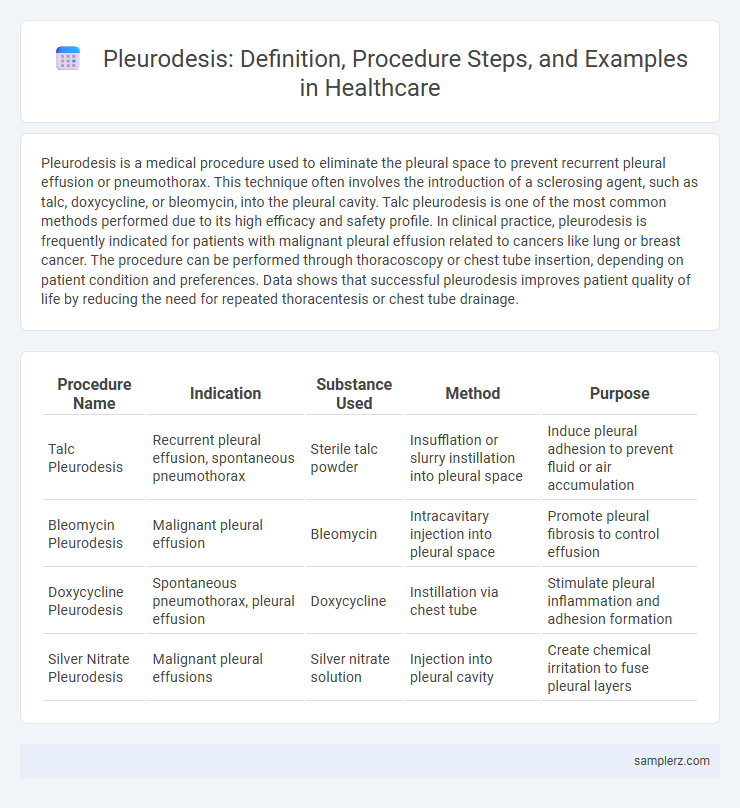Pleurodesis is a medical procedure used to eliminate the pleural space to prevent recurrent pleural effusion or pneumothorax. This technique often involves the introduction of a sclerosing agent, such as talc, doxycycline, or bleomycin, into the pleural cavity. Talc pleurodesis is one of the most common methods performed due to its high efficacy and safety profile. In clinical practice, pleurodesis is frequently indicated for patients with malignant pleural effusion related to cancers like lung or breast cancer. The procedure can be performed through thoracoscopy or chest tube insertion, depending on patient condition and preferences. Data shows that successful pleurodesis improves patient quality of life by reducing the need for repeated thoracentesis or chest tube drainage.
Table of Comparison
| Procedure Name | Indication | Substance Used | Method | Purpose |
|---|---|---|---|---|
| Talc Pleurodesis | Recurrent pleural effusion, spontaneous pneumothorax | Sterile talc powder | Insufflation or slurry instillation into pleural space | Induce pleural adhesion to prevent fluid or air accumulation |
| Bleomycin Pleurodesis | Malignant pleural effusion | Bleomycin | Intracavitary injection into pleural space | Promote pleural fibrosis to control effusion |
| Doxycycline Pleurodesis | Spontaneous pneumothorax, pleural effusion | Doxycycline | Instillation via chest tube | Stimulate pleural inflammation and adhesion formation |
| Silver Nitrate Pleurodesis | Malignant pleural effusions | Silver nitrate solution | Injection into pleural cavity | Create chemical irritation to fuse pleural layers |
Introduction to Pleurodesis in Health Care
Pleurodesis is a medical procedure used to eliminate the pleural space to prevent recurrent pleural effusions or pneumothorax by inducing adhesion between the pleural layers. Common agents for chemical pleurodesis include talc, doxycycline, and bleomycin, which are instilled into the pleural cavity to trigger an inflammatory response leading to fibrosis. This procedure is frequently utilized in patients with malignant pleural effusions or spontaneous pneumothorax to improve respiratory function and quality of life.
Indications for Pleurodesis Procedures
Pleurodesis is primarily indicated for recurrent malignant pleural effusions, persistent pneumothorax, and symptomatic benign pleural effusions unresponsive to conservative treatments. It is commonly employed in cases of metastatic lung cancer, mesothelioma, and recurrent spontaneous pneumothorax to prevent pleural space reaccumulation. The procedure enhances pleural adhesion, thus reducing respiratory distress and improving patient quality of life.
Common Methods Used in Pleurodesis
Common methods used in pleurodesis include chemical agents such as talc, doxycycline, and bleomycin, which induce inflammation and fibrosis to obliterate the pleural space. Talc poudrage is the most widely preferred technique due to its high efficacy and low recurrence rate in treating recurrent pleural effusions and pneumothorax. Mechanical pleurodesis, performed via thoracoscopy, involves pleural abrasion or pleurectomy to achieve similar pleural adhesion through physical irritation.
Talc Pleurodesis: Step-by-Step Example
Talc pleurodesis involves instilling sterile talc into the pleural space to induce inflammation and fibrosis, effectively obliterating the space to prevent recurrent pleural effusion or pneumothorax. After confirmed lung re-expansion via chest X-ray, sterile talc powder is introduced through a chest tube, followed by chest tube clamping for 1 to 2 hours to ensure talc distribution and pleural adhesion. This procedure is commonly indicated in malignancy-related pleural effusions, with success rates exceeding 90% in symptom relief and fluid control.
Chemical Agents Used in Pleurodesis
Chemical agents used in pleurodesis commonly include talc, doxycycline, and bleomycin, which induce inflammation and fibrosis to obliterate the pleural space. Talc remains the most effective and widely used agent due to its strong sclerosing properties and low recurrence rates of pleural effusion. Doxycycline and bleomycin serve as alternatives, particularly in patients who have contraindications to talc or require less aggressive sclerosis.
Surgical Pleurodesis Techniques Explained
Surgical pleurodesis techniques involve creating adhesions between the visceral and parietal pleura to prevent recurrent pleural effusions or pneumothorax. Common methods include mechanical abrasion using a rough pad or pleural scratch, and chemical pleurodesis with agents such as talc, doxycycline, or bleomycin to induce inflammation and fibrosis. These procedures are often performed via video-assisted thoracoscopic surgery (VATS) for precise application and reduced patient recovery time.
Patient Preparation for Pleurodesis Procedures
Patient preparation for pleurodesis procedures involves thorough assessment of lung function and coagulation profile to minimize complications. Pre-procedure imaging, such as chest X-ray or ultrasound, is essential to confirm pleural effusion and guide catheter placement. Patients are advised to fast for at least 6 hours before the procedure and receive prophylactic antibiotics to reduce infection risk.
Post-Procedure Care After Pleurodesis
Post-procedure care after pleurodesis involves monitoring for respiratory complications such as pneumothorax and infection, ensuring adequate pain management, and maintaining chest tube patency to facilitate lung re-expansion. Patients require serial chest X-rays to assess lung adherence and detect possible fluid re-accumulation. Early mobilization and respiratory physiotherapy are essential to enhance lung function and prevent atelectasis.
Complications and Risks of Pleurodesis
Pleurodesis, commonly used to treat recurrent pleural effusions and pneumothorax, carries risks such as pain, fever, and infection at the site of talc or chemical instillation. Respiratory complications including acute respiratory distress syndrome (ARDS) and trapped lung syndrome may also occur, especially with large or repeated pleurodesis procedures. Careful patient selection and monitoring are essential to minimize adverse effects and improve procedural safety outcomes.
Success Rates and Outcomes in Pleurodesis
Pleurodesis, commonly performed to treat recurrent pleural effusions, demonstrates success rates ranging from 70% to 90% depending on the sclerosant used, such as talc or doxycycline. Talc pleurodesis is often preferred due to its higher efficacy and longer-lasting outcomes, with studies reporting symptomatic relief and reduced hospital readmissions. Complications are relatively low, but patient factors and underlying conditions significantly influence the overall success and recurrence rates.

example of pleurodesis in procedure Infographic
 samplerz.com
samplerz.com